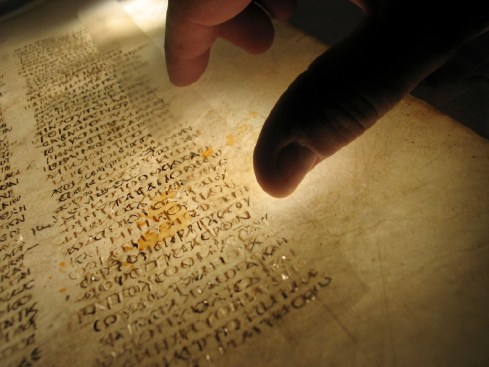I’ve been reading the Old Testament straight through, struggling at times with the accounts reported in the ancient texts. Admittedly, if someone at a party started telling these stories we’d all think they were loony.
There are essentially three possible pronouncements for the passages in the OT that are represented as factual, either:
- They are fictional and/or fraudulent, or
- They are (wholly or partly) allegorical and not meant to be taken literally, or
- The miraculous is in play and the historical accounts are correct.
There is no half-off sale in Christianity—we can’t have the New Testament without the Old. Some poor souls work themselves into torturous and indefensible theological positions by cherry picking which parts of Scripture they accept and which ones they discount as allegorical. Some of them even show up on documentaries wearing clerical collars, affiliated with organizations that have ‘Jesus’ or books of the Bible in their name. Hmmm…. It’s best to think it through yourself.
Is our faith based merely on the hope that the OT is valid, or is there some intelligent basis of assurance?
Well, there is a lot of archaeology out there—much more than we can address in a simple blog post. It would be a gross understatement to say there is no shortage of biblical archaeology. The more they dig, the more the Bible comes out of the ground.
Ironically, the one thing that has never been found is the grave of Jesus, though some have done their damnedest to make the claim that a tomb in East Talpiot once held the bones of Jesus. If you have any doubts about the “lost tomb of Jesus” spend time studying the facts (so you can answer intelligently at parties and elsewhere). The academic community has pretty much unanimously discounted these oafish claims, but people will continue watching these videos and docudramas so be ready to discuss them charitably.
How about apologetics? Likewise, there is no shortage of intellectually sound material to defend the Bible on the web, particularly if you know where to look. How about scientific evidence? Yes, science and faith converge—much more so than most of us can absorb.
What about academic rigor and the field of textual criticism? Experts like Dr. Daniel B. Wallace are doing some amazing work, and are finding that the biblical text is indeed reliable, verifiable and defensible.
What about the NT authors? According to data published by Crossway, the NT cites the OT 263 times. Baker’s Evangelical Dictionary of Biblical Theology cites the United Bible Societies’ Greek Testament listing of 343 quotations, and presents a strong summary of the links between the Old and New Testaments.
But if you really want to know if the OT is valid, the best place to turn is the words of Jesus Christ. Did Jesus validate the OT? Yes, to an astonishing degree. Jews for Jesus lists many of the OT references made by Jesus in the Gospels. Jerry Dearmon suggested after my prior non-genomic mapping of direct citations in the Bible that it would be interesting to look specifically at Jesus’ direct quotations of the OT verses. Jerry suggested I use this data compiled by Steve Clark from BiblePgs.com, based upon research by David H. Phillips first prepared for the Holman Christian Standard Bible, now part of Logos 4 Bible Software. (Don’t miss the prior high-value hyperlink.) According to David Phillips there are 104 NT verses where Jesus directly quotes OT verses. Considering that several accounts in the Gospels are clearly referring to the same conversations of Jesus, and that some source texts are duplicated in the OT, there are 45 distinct quotes from 15 OT books by Jesus in the Bible. So…here you go Jerry, here’s the non-genomic map of those quotations.
These quotations do not include the many instances where Jesus discussed the content of the OT books without making a direct quotation. An example would be the book of Jonah, which Jesus refers to in Matthew 12 and Luke 11. Likewise references to Noah in Matthew 24 and Luke 17 (again, clear references but not direct quotes). When we consider all these other references the number of OT books referred to by Jesus jumps from 15 to 24.
Interpreting the Map
The quotations map is pretty self-explanatory, but here are a few observations:
- Matthew contains most of the quotes, and most of those are from the Torah (Mosaic Law). Jesus had a lot to say about the Law.
- John, writing much later than the other (synoptic) Gospel writers, has far fewer quotations, recording only four of Jesus’ quotes of Psalms and Isaiah. John was writing for a different purpose, but could some of the lack of quotations be attributed to the elapsed time between the events and the writing of his Gospel 60 years or so later?
- Mark, the shortest Gospel, has 32 quotations from 9 OT books. Using the same logic could we argue that Matthew and Mark were written earlier than Luke and John on the basis of the number of quotations?
- Referencing my prior post tying the OT to Hebrew history, Jesus quotes from some of the earliest and latest books of the OT, spanning 1,000 years of Jewish history. There is no record of Jesus attempting to correct anything written in Jewish history (although He certainly had a lot to say about interpretations of the Tanakh).
- If you look at the grouping of color bands where they link to the OT books, a lot of corroboration is apparent. Only three OT books stand alone in the Gospels (Ezekiel in Mark, Joshua in Mark, and Numbers in Matthew).
- The direct quotations by Jesus support canonization of these books in the Christian Bible.
- Though not apparent in the map, while we’re on the subject of canonization, Jesus never quoted from the Apocrypha.
- Only Psalms and Isaiah are quoted by Jesus in all four Gospels. As shown in a prior post, based upon citations among the biblical authors these were arguably the two most influential books in the Bible.
The OT was the missional platform from which Jesus operated. I am still amazed that God works by processes—He doesn’t just poof everything to be the way it is, it takes time. The OT and all that history had to precede the NT.
After all this bird dogging, recognizing that the Bible does clearly contain allegory, poetry, songs, prophecy and many other forms of literature, I accept the historical literature as historical, including the miraculous accounts, because they were clearly portrayed as such by Jesus. That’s good enough for me.
HT: Jerry Dearmon; Krzywinski, M. et al. Circos: an Information Aesthetic for Comparative Genomics; Crossway Bibles and Jim Darlack; and David H. Phillips.




July 5th, 2013 at 7:44 pm
John, a numbers of years ago I had a similar conversation with my brothers. One said that some of the Bible particularly the OT. I asked him ok, how do we decide which parts are we to believe are true and which parts do we take as just stories? Then I told him, you already believe the the most improbable story in the entire Bible, that Jesus died, laid in a tomb three days and then rose from the grave. If you believe that the rest is “easy”. As you know Hugh Ross has a number of books on how science is proving the Biblical accounts of creation. Thanks again for a great post, David
LikeLike
July 6th, 2013 at 8:24 am
Thanks David, and you make a great point. Likewise we believe that God can create the universe ex nihilo, but then question whether he intervenes with His creation at times with the miraculous. C.S. Lewis gave an exhaustive and profound treatment of that topic in his Miracles text.
It is also interesting to consider how Christianity fits together like a chain. The OT is validated by Jesus, who was subsequently served by the witness of Paul:
“That is why I am suffering as I am. Yet I am not ashamed, because I know whom I have believed, and am convinced that he is able to guard what I have entrusted to him for that day.”
2 Timothy 1:12 (NIV)
LikeLike
July 6th, 2013 at 1:45 pm
Thanks John for the research and translation in producing the graph. What better example that the biblical text is indeed reliable, verifiable and defensible as Dr. Wallace proclaims.I continue to be amazed at the complexity of the WORD and how it hangs together for the most learned investigator but yet simple enough for a child to see the true meaning. In my early days of accepting the validity of Christianity I always was confirmed by how a document “written” by so many authors over so long a period of time had such an indisputably integrated meaning.
Well done!
jerry
LikeLike
July 6th, 2013 at 4:24 pm
That’s the joy of Personal Discipleship–the more you study, the more the Bible comes together, and the more interesting it becomes.
Thanks for the input and support! (Hope you enjoyed the beach!)
LikeLike